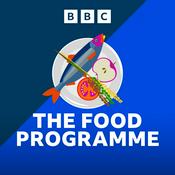Cider Chat

486 odcinków

483: The Talking Pomme's Grand Winter Party
24.12.2025 | 14 min.
Enjoy this annual winter tale from Cider Chat Central! In this special holiday episode, Cider Chat invites you to step into the enchanting world of the Talking Pommes. The Talking Pommes Grand Winter Party is more than just a story - it's a celebration of all things pome, community, tradition, and the joy that comes with every glass of cider. The cider house hums with anticipation as Ria, Perry Pear, Mr. Quince, and the Medlars prepare the night before their annual pressing. But as every year before there is always magic in the air for Ciderville. With the Talking Pommes truly anything can happen and so it does! With snow blanketed orchards, and just the right amount of "Believe" a sleigh pulled by apples glides through the starry sky. Raise a glass and join us on this festive adventure—because in Ciderville, the magic is always just a sip away. Meet the Stars of the Cider House This holiday episode of Cider Chat brings together some of Ciderville's most delightful characters: Apple: The vibrant leader with a twinkle in their eye. The Medlars: Sweet, quirky, and always ready with a witty remark. Mr. Quince: The taskmaster who wants to be a comic Perry Pear: Full of charm and flair, a natural performer. A Wide Assortment of Pommes: From Dabinett to Kingston Black, they bring their unique personalities to the mix. The Gift of Holiday Cider Magic This story is for anyone who cherishes the magic of the season. As Apple says, "Every glass of cider holds a story, and this one's for you." From Cider Chat to all of Ciderville, we hope this episode brings joy to your holiday season. Raise a glass, gather 'round, and join the Talking Pommes and Ria in Ciderville!

482: FLX Cider & Cheese Pairing with Cheesemonger Rachel Freier
17.12.2025 | 41 min.
At the New York Cider Fest in November, there were 2 Cider and Cheese sessions. Cider Chat Emcee Ria Windcaller attended one featuring ciders from 4 different makers. This cider and cheese pairing was led by Rachel Freier, a cheesemonger who is based in the Finger Lakes. She brought deep knowledge, humor, and a whole lot of heart as we tasted our way through four ciders and three cheeses. 00:00 Introduction to New York City Cider Fest 01:55 Networking at the Cider Fest 02:50 Exploring the Finger Lakes Cider Scene 04:36 Upcoming Cider Tours and Events 09:32 Cider Making Tips and Anecdotes 13:46 Featured Presentation: Cider and Cheese Pairing 23:31 Sterilizing Juice and Grape Skins 23:41 Exploring Apple Varieties: Northern Spy and Crab Apples 24:06 Harvesting Feral Fruit and Gnarly Branch Rose 24:51 Pairing Cider with Cheese 25:31 The Finger Lakes Cider Scene 26:09 Cider and Goat Cheese Pairings 27:19 Kingston Black: The King of Apples 30:16 The Art of Blending Ciders 31:09 Sustainable Cheese Making 33:43 Chisel Jersey Cider and Cheese Pairing 36:19 Upcoming Cider Chat Episodes 37:20 Celebrating the Holidays with Cider 39:23 Musical Outro: Strange Apples Contact Info for the Ciders and Rachel Rachel Freier, (Cheesemonger): Eve's Cidery - Maker Ezra Idiot Brother Cider - Maker Robert Grisamore/ Cider Works - Maker Simon South Hill Cider - Maker Steve Mentions in this Cider Chat Episode 198: Becoming a Pomologist w/ Dr. Peck Totally Cider Tours UK tour feature in CAMARA's Pint West Patron Letter - Sune 2026 Blossom Time Totally Cider Tour The Talking Pommes' Grand Winter Party Annual Special Episode

481: Totally Cider Tour: A Merry Visit to Tom Oliver's
10.12.2025 | 44 min.
Tom Oliver is delightfully talented, mischievously witty, and not only a renowned cider maker but also a top-notch perry maker. He may say, "If you're going to make perry and work with pears, you've already identified yourself as being criminally insane," but what we found was simply a bold maker willing to go the extra mile for every bottle. Enjoy this audio snap shot at Oliver's Cider and Perry Herefordshire, recorded on the 2025 Totally Cider Tour_UK Edition. Hear him share the story behind transforming his family's old hop barns into the heart of his cider and perry production, offering listeners a rare look into his traditional farmhouse methods. He discusses the challenges and joys of working with tannic cider apples and perry pears, spontaneous fermentation, barrel aging, and the evolving climate's impact on cider making. Tom has been featured in many Cider Chat® episodes and will be one of the select scheduled stops on the 2026 UK Blossom Time Totally Cider Tour. 00:00 Introduction to Perry and Cider Making 00:17 Meet the Host and Guest 00:57 Totally Cider Tour Experience 03:28 Challenges of Perry Making 04:11 Foraging and Traditional Perry Making 05:09 The Importance of Known Varieties 06:28 Cider Preferences and Quality 07:43 Totally Cider Tours - UK 10:18 Tom Oliver's Cidery Tour 11:47 Barrel Room Insights 13:08 Perry and Cider Fermentation 14:35 Pressing and Storing Fruit 15:51 Unique Perry Varieties 21:48 Barrel Aging and Tasting 25:03 Introduction to Fermentation 25:49 Wild Fermentation Process 27:11 Saccharomyces Yeast Role 28:34 Fermentation Containers and Aging 29:26 Bottling and Release Plans 29:44 Fermentation Under Pressure 32:28 Temperature and Duration of Fermentation 33:43 Challenges with Temperature Control 36:31 Barrel Cleaning and Maintenance 38:27 Regulations and Environmental Concerns 40:54 Conclusion and Future Plans Topics Covered The transformation of Oliver's hop barns into barrel rooms The shift from hops (Fuggles, Northdown, Target) to cider and perry fruit Why perry making is "a walk through madness" compared to cider The discipline of pressing and storing tannic pears at their peak Wild fermentation: apiculate vs. Saccharomyces yeast and how they shape flavor Barrel aging as both art and alchemy The sensory nuance of minerality and mouthfeel Keeping barrels "organically clean" for wild ferments Rising temperatures and the modern challenges of traditional cider making Perry Pear Varieties Mentioned Butt – dense and slow to soften; can store for weeks Thorn – softens quickly, needs immediate pressing Judge Amphlett – early ripening, fast fermenting Winnall's Longdon – honeyed, complex, but fragile and quick to spoil Yellow Huffcap – rich tannins, aromatic, often over-ripens on the tree Ciders & Perrys Tasted Eskimo Eyes Perry – 6% ABV, aged six months in rum and white wine barrels. A still perry that balances delicate fruit, subtle oak, and lingering depth. Barrel-Aged Still Cider – 9.2% ABV, matured 18+ months in Irish whiskey and Scotch barrels, bringing notes of minerality, oak, and sherry-like warmth. Call to Action If you've ever wondered whether you're bold enough to make perry, this episode will either inspire — or warn — you. Join Tom Oliver and other makers on the upcoming 2026 Blossom Time Totally Cider Tour, and hear more stories from the barrel rooms of cider's most daring artists at CiderChat.com. Send an email today to mailto:[email protected] Contact info for Oliver's Cider & Perry (Tom Oliver) Website: https://oliversciderandperry.co.uk/ Mentions in this Cider Chat Blossom Time Totally Cider Tour 2026 – get on the wait list today! send an email to [email protected] and let us know how many slots you would like to have us keep open for you!

480: Holiday Cider Gift Guide 2025 and Playing with Pommeau
03.12.2025 | 46 min.
00:00 Introduction and Podcast Overview 00:32 French Pronunciation Fun 02:27 Holiday Gift Ideas for 2025 02:59 Cider Chat News and Updates 04:42 Listener Stories and Experiences 07:49 Upcoming UK Cider Tour 2026 12:47 Featured Presentation: 2025 Holiday Cider Gift Guide 13:35 Cider Chat Partners and Supporters 25:30 Stocking Stuffer Tips and Cider Supplies 31:36 The Perfect Name for American Pommeau 45:24 Conclusion and Final Thoughts 00:00 Introduction and Language Fun 00:14 Cider Chat Episode 480 Overview 01:10 Naming Poot in America 02:27 Holiday Gift Ideas for 2025 02:59 Cider Chat News and Updates 03:08 New Patron and Michelin Star Connection 04:42 Michael of Edulis Cider Journey 06:25 Rising Costs of Starting a Cidery 07:49 Blossom Time Tour 2026 12:47 Holiday Cider Gift Guide 13:35 Cider Chat Partners and Supporters 25:30 Stocking Stuffers and Cider Supplies 31:36 The Perfect Name for American Pommeau 41:32 Conclusion and Final Thoughts Find full episode show notes and links at https:ciderchat.com

479: New York Cider Fest | Audio Snapshots
26.11.2025 | 51 min.
New York Cider Fest 2025 brought together makers and enthusiasts for an unforgettable day at City Winery Manhattan. In this special collection of on-the-floor recordings, Cider Chat® captures Audio Snap Shots with festival patrons. Hear how attendees at the New York Cider Fest are viewing cider today — what styles they're excited about, how they're drinking it, and the foods they love to pair with a glass, including their favorite Thanksgiving matches. Episode Timeline 00:00 Introduction to Cider Chat 02:34 Exciting News: Totally Cider Tours 10:21 Feature Presentation: New York Cider Fest 12:24 Listener Snapshots: Cider Enthusiasts Share Their Stories 18:45 Exploring Cider Pairings and Preferences 19:22 Cider Travels and Discoveries 25:17 Food Influencers at Cider Fest 28:05 Meet the Food Bloggers 28:35 Kylie and JJ's Cider Journey 32:30 Katie's Fruity Cider Favorites 39:09 AJ's Tequila and Cider Combo 42:22 Adventurous Ashley's Cider Travels 45:48 Cider's Growing Popularity 47:56 Join the UK Cider Tour 49:20 Cider Song Finale Contact info for the New York Cider Fest The New York Cider Association hosts this annual event – go to their website at https://www.newyorkciderassociation.com/ Mentions in this Cider Chat 2026 Blossom Time Totally Cider Tour April 27th – May3rd Guest Instagram accounts on this episode @roommatesfeasting @fontanas_food @adventuressashley
Więcej Sztuka podcastów
Trendy w podcaście Sztuka
O Cider Chat
Słuchaj Cider Chat, ill-advised by Bill Nighy i wielu innych podcastów z całego świata dzięki aplikacji radio.pl

Uzyskaj bezpłatną aplikację radio.pl
- Stacje i podcasty do zakładek
- Strumieniuj przez Wi-Fi lub Bluetooth
- Obsługuje Carplay & Android Auto
- Jeszcze więcej funkcjonalności
Uzyskaj bezpłatną aplikację radio.pl
- Stacje i podcasty do zakładek
- Strumieniuj przez Wi-Fi lub Bluetooth
- Obsługuje Carplay & Android Auto
- Jeszcze więcej funkcjonalności


Cider Chat
pobierz aplikację,
zacznij słuchać.






























